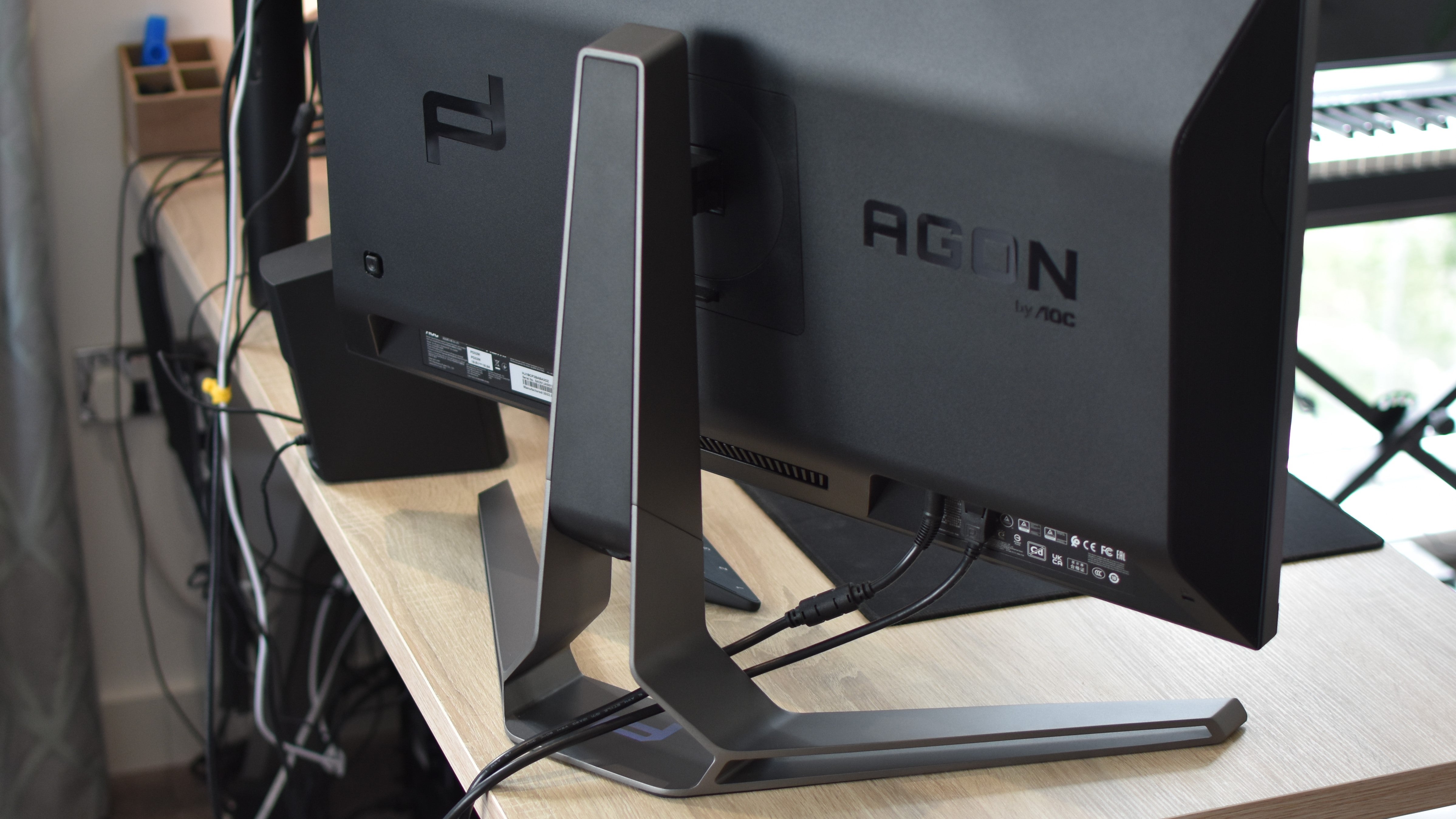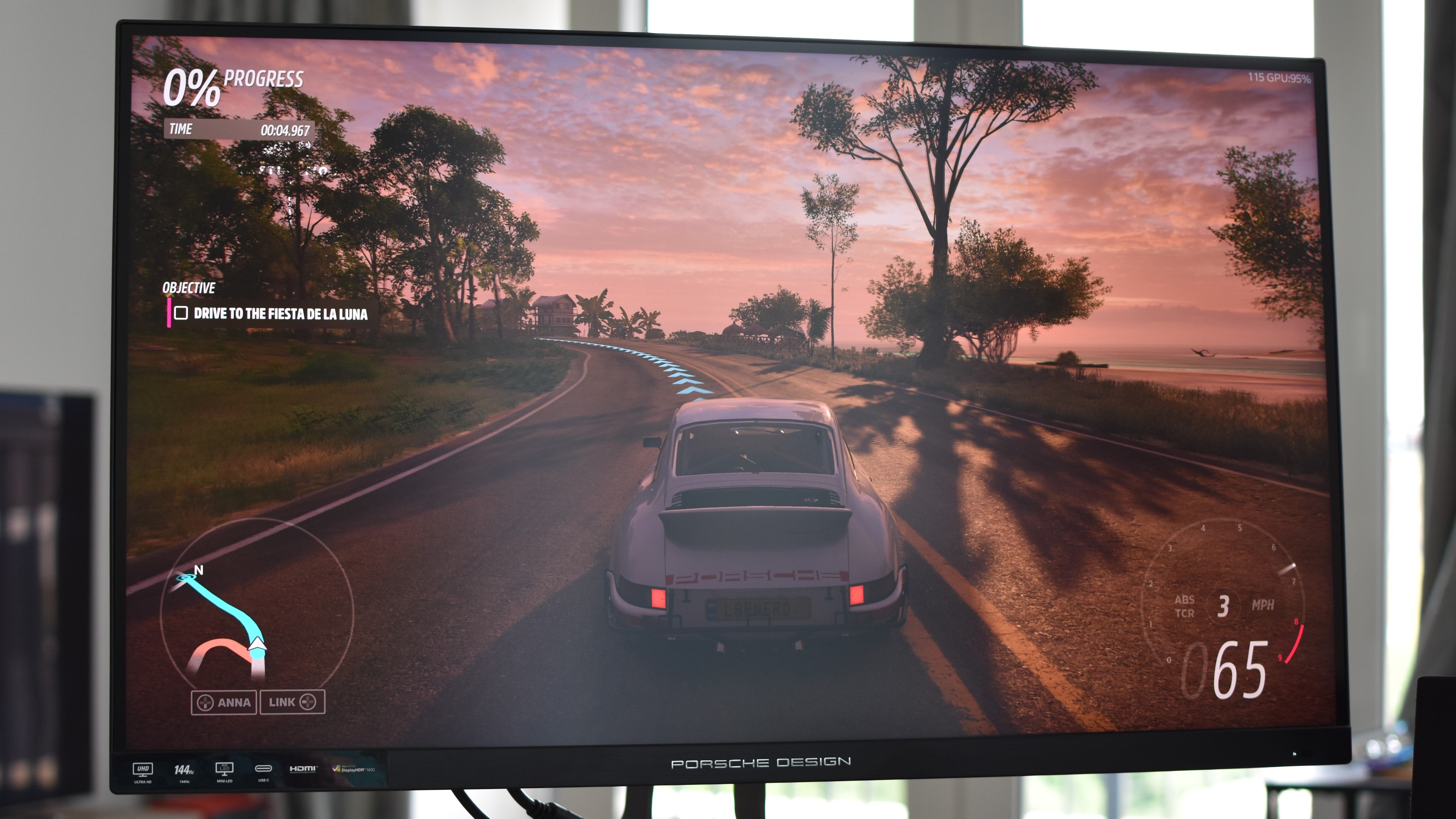Products You May Like
Here we have another AOC gaming monitor, except it’s not just by AOC, but by posh car makers Porsche? It’s the Porsche Design AOC Agon Pro PD32M, a premium 4K / 144Hz beast of a display, and is in fact the second hardware collaboration between these unlikely bedfellows.
It’s also far more ambitious (and expensive) than 2020’s AOC Agon PD27. It’s flat rather than curved, but goes for both a higher resolution and a larger 31.5in IPS panel. Its DisplayHDR certification also rises from 400 to 1400, fuelled largely by a switch to more advanced Mini LED backlighting: the same sort as the Asus ROG Swift PG32UQX, one of the best 4K gaming monitors. As a gaming screen, then, it’s got all the right tools, but what exactly about it is Porsche-like?
Granted, it’s been some years since I last owned a car, and it sure as hell wasn’t a Porsche. But if I hadn’t read on the Porsche Design website that the Agon Pro PD32M borrows some trapezoid shapes from their steering wheels, I’d be absolutely left wondering how this monitor is supposed to evoke the brand in question. It has lights on the back, not entirely unlike a car, but there are no wheels, no sloping roof, and not even a hint of past involvement in the German war machine. Conversely, the Agon PD27’s stand was immediately recognisable as an homage to racing roll cages, not to mention a genuinely unique design flourish among gaming displays.
And yet, perhaps the Agon Pro PD32M’s less overt Porsche styling is an improvement. I don’t really want a race car monitor any more than I want Lightning McQueen pajamas, and while one racing-style gaming chair has won me over, that was owing much more to its practicality than it simply aping a bucket seat. The Agon Pro PD32M’s stand is similar: it’s not great because it looks like it was band-sawn off a steering wheel, it’s great because it’s reliably sturdy, impressively adjustable, and reassuringly heavy. I do actually like how it looks, for the record, but the weight and aluminium construction of this stand give a hint of the Agon Pro PD32M’s quality as soon as it comes out of the packaging.

Less convincing is the decision to put a downwards-projecting, decorative light over what should clearly be a cable routing gap, but the IPS panel serves well as a distraction. It is, in a word, gorgeous – searing bright even with HDR switched off, richly colourful, and smooth in motion. It supports both AMD FreeSync and Nvidia G-Sync, the latter delivering perfect tear prevention when I tested it on an RTX 3090, and is practically free of ghosting (and inverse ghosting) on default settings.

A more forensic approach reveals some imperfections: contrast, for instance, could be a lot better than 867:1. I also measured an average delta-E of 4.4, which is relatively high, so although the Agon Pro PD32M’s colours are bold they’re not particularly accurate. High accuracy is better for image editing than gaming, though, and despite the so-so contrast ratio, there’s more than enough pop.
Using Mini LED tech instead of cheap, edge-lit backlighting helps. With HDR off, brightness peaks at a beaming 542.7cd/m2, and turning it on produced up to 802.cd/m2 in Final Fantasy XV.

True, that’s not the 1400cd/m2 that DisplayHDR 1400 is supposed to promise, and you’d get better performance overall from the ROG Swift PG32UQX (thanks in part to its superior contrast). But while I also don’t entirely buy the Agon Pro PD32M’s claimed 1ms G2G response time, its IPS panel handles motion just as well as the Asus monitor. Plugged into a PC that can cope with the rigours of high refresh rate gaming at 4K, the Agon Pro PD32M makes bombing around Forza Horizon 5 or hot-dropping into an Apex Legends match feel as fast and smooth as they would on any of the best gaming monitors.
It’s cheaper than the ROG Swift PG32UQX, too. A lot cheaper: Porsche Design sell it direct at £1750 / $1799, which is nearly half of what Asus want for their own 32in, 4K, 144Hz, HDR-ready, Mini LED gaming monitor. Comparisons with smaller, lower-specced 4K displays are less flattering but for all the features and performance that the Agon Pro PD32M provides, it’s priced much more aggressively than it looks.

Porsche and AOC throw in a few nice bonuses as well. There are well-hidden headset hooks on both edges, the HDMI ports meet the 2.1 standard (ideal if you also own a 4K-capable games console like a PS5), and as with the PD27, you get a cute little remote control in the box. This is no piece of excess desk clutter: using it to navigate the OSD is a thousand times easier than the solution of most monitors, which is to use tiny buttons or a rear-mounted joystick on the monitor itself. The Agon Pro PD32M does have a backup joystick, but I’ll prefer its dedicated controller over any awkward behind-the-screen arm stretching any day.

The worry with luxury brand sticking their fingers in tech hardware is that you can end up paying more just for the name. Not so with the PD32M: it’s a lovely looking screen that, while not cheap per se, is rather reasonably priced for its specs and performance. If you want all the speed and sharpness of a 4K / 144Hz monitor while also making a step up on HDR, a Mini LED model like this could do you very well. Even if you’re not a steering wheel enthusiast.
On that note, the Agon Pro PD32M also gives me ideas for other car-themed gaming displays; perhaps a BMW monitor that only works when it’s pressed up uncomfortably close to peripherals in front of it. Or a Tesla monitor that can take over playing a game for you before bursting into flames.
